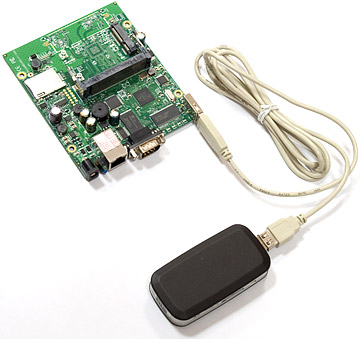Option Globetrotter HSDPA USB Modem
Document Revision 2009-10-28: RouterOS changes since V4.2
Introduction
This example shows how to get the Option Globetrotter HSDPA USB Modem working with LMT (Latvian Mobile Telephone UMTS/GPRS networks), or with Amigo (GPRS network) in Latvia. Service in your country might have different requirements and strings, but this is just to give you an outline of what is required.
Hardware
USB Modem: Option N.V. Globetrotter HSDPA USB Modem H7.2
 Modem manufacturer: Teltonika, model number U3G150
Modem manufacturer: Teltonika, model number U3G150
Router Hardware: MikroTik Router with USB port(s) (RB230, any x86 system, RB433UAH, or, RB411U)
Router Software
RouterOS V4.2. Works in previous versions 2.9 and 3, but slightly different configuration.
The USB Modem is recognized in RouterOS as an USB device and listed under the USB resources:
[admin@rb411u] > /system resource usb print # DEVICE VENDOR NAME SPEED 0 2:1 RB400 EHCI 480 Mbps 1 1:1 RB400 OHCI 12 Mbps 2 1:3 Option N.V. Globetrotter HSDPA... 12 Mbps [admin@rb411u] >
Make sure the USB port is listed under the port menu:
[admin@rb411u] > /port print Flags: I - inactive # NAME CHANNELS USED-BY BAUD-RATE 0 serial0 1 Serial Console auto 1 usb2 3 9600 [admin@rb411u] >
Prior RouterOS V3.23, a modem had all its ports listed. Since V3.23 there is one port per modem, and modem has channels used for commands and data. Channels have numbers 0,1,2, etc. Some modems may have just two channels, some have more. Set the baud rate to 9600 for communicating with the modem, in case it's not done already:
[admin@rb411u] > /port set usb2 baud-rate=9600
Check the modem responses using serial-terminal, like this:
[admin@rb411u] > /system serial-terminal usb2 channel=2 [Ctrl-A is the prefix key] ATI Manufacturer: Option N.V. Model: GTM378 Revision: 2.3.3Hd (Date: Jul 17 2007, Time: 15:49:23) OK
Disconnect from the modem, by pressing "Ctrl-A", and then "Q":
[Q - quit connection] [B - send break] [A - send Ctrl-A prefix] [R - autoconfigure rate] Welcome back! [admin@rb411u] >
Workaround for Globetrotter devices offering no modem interface
There is no guarantee that the commands above work on all the modems that need the HSO driver. The tested device was a T-Mobile branded Globetrotter iCON 225 "web'n'walk Stick". That device was able to connect without problems after the method described. Some Globetrotter HSDPA cards, for example the iCON 225 (branded as Orange, T-Mobile web'n'walk stick, etc. have the serial modem interface disabled by default, and only offer an NDIS network interface for the data connection. If a dial command is issued, but no CONNECT response happens from the modem, it might be helpful to check this. To check on the setting, issue:
[admin@MikroTik] > /system serial-terminal port=usb1 channel=0
[Ctrl-A is the prefix key]
ATZ
OK
ATI0
Manufacturer: Option N.V.
Model: GlobeTrotter HSDPA Modem
Revision: 2.5.24Hd (Date: Apr 17 2009, Time: 08:59:36)
OK
AT_OIFC?
_OIFC: 2,1,1,0
OK
AT_OIFC=?
_OIFC: [2-3], [0,1], [1], [0-5]
mdm, diag, app1, pcsc/gps
MDM (0: N/A) (1: N/A) (2: ndis) (3: modem and ndis)
DIAG (0: none) (1: enable)
APP1 (0: none) (1: enable)
PCSC/GPS (0: none) (1: pcsc enable) (2: GPS enable) (3: app2 enable) (4: GPS & PCSC) (5: GPS & app2)
OK
In this example, the MDM (modem) interface is set to 2, so no serial modem interface is enabled in the device.
To change the setting, issue:
AT_OIFC=3,1,1,0
You should get: OK
To write the change permanently to the NVRAM of the device, issue:
AT&W
Unplug and re-plug the device, and issue:
[admin@MikroTik] > /port print Flags: I - inactive # NAME CHANNELS USED-BY BAUD-RATE 0 usb1 4 9600
Number of channels should have increased. On the tested device, the last channel is the modem-interface (number 3 in RouterOS).
According to [1] the Linux HSO driver page at least five Option devices exist which do not have the modem interface enabled by default.
Router Configuration for PPP
Since RouterOS V4 (and latest versions 3) the PPP client configuration is made much easier compared to previous versions. There is no need to use ppp profiles, and ppp-client interface might have been added automatically to the /interface ppp-client list:
[admin@rb411u] > /interface ppp-client
[admin@rb411u] /interface ppp-client> print
Flags: X - disabled, R - running
0 X name="ppp-out1" max-mtu=1500 max-mru=1500 mrru=disabled port=usb2
data-channel=2 info-channel=2 apn="internet" pin="" user="" password=""
profile=default phone="" dial-command="ATDT" modem-init=""
null-modem=no dial-on-demand=yes add-default-route=yes use-peer-dns=yes
allow=pap,chap,mschap1,mschap2
[admin@rb411u] /interface ppp-client> info 0
The interface has 3G/GPRS modem specific arguments, like apn, pin. Consult your network provider what to use for APN, user, and password. Adjust your peer-dns and default-route settings according to what you want to do over that interface! In our case, we want permanent connection and won't use dial on demand:
[admin@rb411u] /interface ppp-client> set 0 dial-on-demand=no
[admin@rb411u] /interface ppp-client> enable 0
[admin@rb411u] /interface ppp-client> print
Flags: X - disabled, R - running
0 R name="ppp-out1" max-mtu=1500 max-mru=1500 mrru=disabled port=usb2
data-channel=2 info-channel=2 apn="internet" pin="" user="" password=""
profile=default phone="" dial-command="ATDT" modem-init=""
null-modem=no dial-on-demand=no add-default-route=yes use-peer-dns=yes
allow=pap,chap,mschap1,mschap2
[admin@rb411u] /interface ppp-client>
After enabling the interface watch the logs to see how the connection is being established over the USB modem:
[admin@rb411u] /interface ppp-client> /log print 12:29:16 async,ppp,info ppp-out1: initializing... 12:29:16 async,ppp,info ppp-out1: reseting link... 12:29:16 system,info device changed by admin 12:29:16 system,info dns changed 12:29:17 async,ppp,info ppp-out1: initializing modem... 12:29:17 async,ppp,info ppp-out1: dialing out... 12:29:17 async,ppp,info ppp-out1: authenticated 12:29:20 async,ppp,info ppp-out1: could not determine remote address, using 10.112.112.119 12:29:20 async,ppp,info ppp-out1: connected 12:29:20 system,info dns changed [admin@rb411u] /interface ppp-client>
The serial port is used by ppp client:
[admin@rb411u] > /port print Flags: I - inactive # NAME CHANNELS USED-BY BAUD-RATE 0 serial0 1 Serial Console auto 1 usb2 3 PPP <ppp-out1> 9600 [admin@rb411u] >
Check the addresses, in our case we have:
[admin@rb411u] > /ip address print Flags: X - disabled, I - invalid, D - dynamic # ADDRESS NETWORK BROADCAST INTERFACE 0 D 10.5.8.64/24 10.5.8.0 10.5.8.255 ether1 1 D 10.40.192.214/32 10.112.112.119 0.0.0.0 ppp-out1 [admin@rb411u] >
and routes:
[admin@rb411u] > /ip route print Flags: X - disabled, A - active, D - dynamic, C - connect, S - static, r - rip, b - bgp, o - ospf, m - mme, B - blackhole, U - unreachable, P - prohibit # DST-ADDRESS PREF-SRC GATEWAY DISTANCE 0 ADS 0.0.0.0/0 10.112.112.119 1 1 ADC 10.5.8.0/24 10.5.8.64 ether1 0 2 ADC 10.112.112.119/32 10.40.192.214 ppp-out1 0 [admin@rb411u] >
You can get more status information about the modem and network by running the "info" command. In our case the modem uses the same channel for data and info, thus, we disable the ppp-client and run the "info" command then:
[admin@rb411u] /interface ppp-client> info 0
failure: can't reuse channel while ppp-client running!
[admin@rb411u] /interface ppp-client> disable 0
[admin@rb411u] /interface ppp-client> info 0
status: "ready"
pin-status: "no password required"
functionality: "minimum"
gprs-class: "A - GPRS & GSM simultaneous"
manufacturer: "Option N.V."
model: "GTM378"
revision: "2.3.3Hd (Date: Jul 17 2007, Time: 15:49:23)"
serial-number: "356237010662581,S23977B51N"
current-operator: "LV LMT GSM"
access-technology: "3G"
signal-strengh: -89
[admin@rb411u] /interface ppp-client>
You may need to use masquerade to hide your private network when going out through the ppp!
Modem Preferred Operation Settings
OPTION modems can be set for preferred operation in UMTS(3G) or GPRS networks. To change the operation mode, use AT_OPSYS command via terminal, or, include it into the modem init string:
AT_OPSYS=0,2 Only GPRS AT_OPSYS=1,2 Only UMTS(3g) AT_OPSYS=2,2 Prefer GPRS over UMTS(3G) AT_OPSYS=3,2 Prefer UMTS(3G) over GPRS
Query the current _OPSYS setting using the AT_OPSYS? command:
[admin@rb411u] > sys serial-terminal usb4 channel=0 [Ctrl-A is the prefix key] AT_OPSYS? _OPSYS: 3,2 OK
The _OPSYS operation mode setting stays intact after router reboot or power off/on. If you lock the modem operation setting to 3G only, the scan command won't show GPRS networks, and vice versa.
Troubleshooting
- You do not get "authenticated" and "connected"
- There is something wrong with your settings. Most likely, the ppp-client interface settings should be changed to match your provider's requirements.
- If the data-channel setting is wrong, there will be no connection. The number of available channels is shown under the /port list, port numbers start with 0. Disable the interface and try another port number!
- Check if you can communicate with the modem by using the serial-terminal! Make sure the ppp-client is disabled!
- Turn off PIN request for your SIM card, it makes the life much easier. Do it in a phone if you do not know the correct AT command.
- Speed of the link is not what expected
- It's possible that the modem has connected to GPRS network, not 3G. Use the "scan" command for list of available networks:
[admin@rb411u] /interface ppp-client> scan 0 Flags: C - current, A - available, F - forbidden OPERATOR CODE ACCESS-TECHNOLOGY SIGNAL-STRENGH C LV LMT GSM 24701 GSM compact -65 A LV LMT GSM 24701 3G F BITE LV 24705 3G F LV TELE2 24702 GSM compact F LV TELE2 24702 3G F BITE LV 24705 GSM compact -- [Q quit|D dump|C-z pause]
- Multiple inits (multiline inits) are required
- It is possible by dividing them using ; character. Example:
modem-init="AT+CGDCONT=5,\"IP\",\"internet.lmt.l\";AT+CGDCONT=6,\"IP\",\"internet.lmt.lv\";AT"
- Modem is not recognized after reboot (port becomes invalit)
- It is recomended to disable built-inf flash/cd drive. Here are some command for few modem brands:
- ZTE modems:
Read more>> - AT+ZCDRUN=8 disable
- AT+ZCDRUN=9 enable
- HUAWEI modems:
Read more>> - AT^U2DIAG=256
Typical things to check
- sms sending not working
- check port
- check PIN
- enable debug logging GSM, DEBUG
- check log
- create supout
- sms receiving not working
- check port
- check PIN
- got delivery accounting sms ?
- allowed-number is correct with country code prefix +XXX ?
- secret matches ?
- check sms store directly /sys serial usbX by issuing command at+cmgl=1 (lists all messages in message store)
- enable debug logging GSM, DEBUG
- check log
- create supout
- ppp client not working
- check port
- check PIN
- dial-on-demand is set to no?
- apn correct?
- needs special modem-init (to handle PIN use at+cpin=XXXX) ?
- enable debug logging with topics ASYNC, DEBUG
- check log
- create supout
- ppp info not working
- check port
- uses same channel info-channel == data-channel (can't work while ppp-client is enabled) ?
- enable debug logging with topics ASYNC, DEBUG
- check log
- create supout
- ppp info command reports functionality=minimum
- use /system serial-terminal usbX channel=X and execute the at+cfun=1
- ppp info command should report functionality=full
- If after each reboot the functionality is in minimum state add the at+cfun=1 into the modem-init field
- after executing some AT commands the modem doesn't respond correctly or reports error values
- resetting the modem functionality might solve the problem
- use /system serial-terminal usbX channel=X
- execute the at+cfun=0 command and wait few seconds and execute at+cfun=1
- port invalid or not working
- unplug the modem
- disable the ppp-client interface
- reboot the router
- plug in the modem and after 5s proceed to nex step
- create supout
- modem stops responding
- upgrade the modem firmware and check if it solves the problem
- create supout
To check port
- port busy ? /port print (check used-by)
- channel busy ? (two application can't use same channel)
- is chosen channel working? check if you get any output /sys ser usbX channel=X with command ATI
- port shown ? /port print
- device shown ? /sys reso usb pr
- create supout
To check PIN
- /int ppp-client info CONNAME or run /sys serial usbX and issue at+cpin?
- enter pin at+cpin=XXXX
To create supout
- run /sys sup-output
- contact support and provide supout file
Additional Resources
Huawei_EVDO WiKi Page with similar setup for a PCMCIA modem
Teltonika HomePage of the USB modem manufacturer
